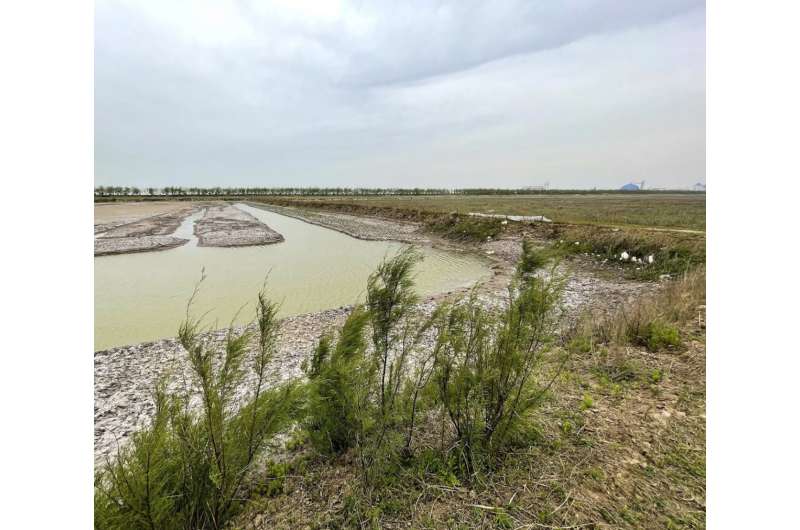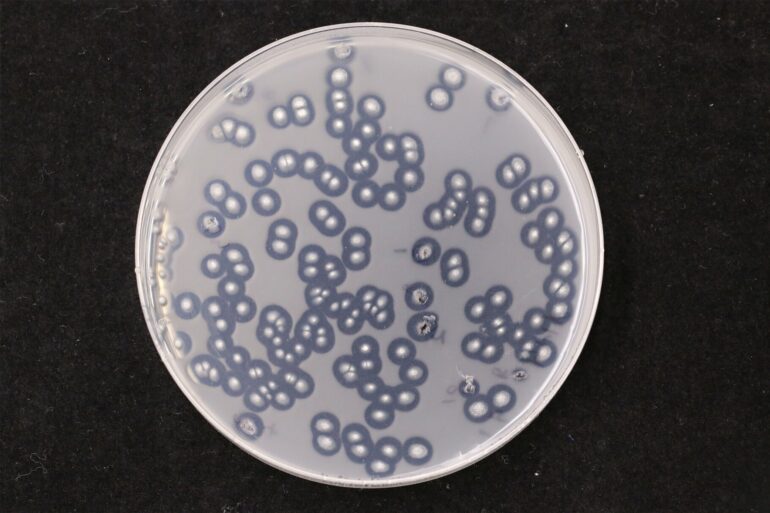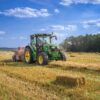A new study published in the Journal of Hazardous Materials by researchers at the Royal Botanic Gardens, Kew, and partners has identified a diverse microbiome of plastic-degrading fungi and bacteria in the coastal salt marshes of Jiangsu, China.
The international team of scientists counted a total of 184 fungal and 55 bacterial strains capable of breaking down polycaprolactone (PCL), a biodegradable polyester commonly used in the production of various polyurethanes. Of these, bacterial strains within the genera Jonesia and Streptomyces have the potential to further degrade other petroleum-based polymers—natural or synthetic chains of molecules bound together.
The plastic-degrading microorganisms were sampled in May 2021 from Dafeng in eastern China, a UNESCO-protected site near the Yellow Sea Coast. The sampling confirmed the presence of a terrestrial plastisphere, a term that is relatively new to terrestrial ecology as past studies have primarily focused on marine environments. The microbiome of this “man-made ecological niche” of coastal plastic debris was further found to be distinct from the surrounding soil.
Scientists are increasingly looking at microorganisms, such as fungi and bacteria, to help tackle some of the most pressing challenges of the modern age, including the rising tide of plastic pollution. According to the United Nations Environment Program (UNEP), 400 million tons of plastic waste is produced annually, with a steep increase in levels of plastic pollution since the 1970s. Researchers are, however, hopeful that answers to this problem could be found in the plastisphere.
Past research has already recognized the potential of microorganisms to tackle plastic waste; a 2017 study led by researchers from China and Pakistan identified a strain of the fungi Aspergillus tubingensis that was breaking down plastic at a landfill in Islamabad, Pakistan. To date, 436 species of fungi and bacteria have been found to degrade plastic and Kew scientists and partners believe their latest findings could lead to the development of efficient enzymes designed to biologically degrade plastic waste.
The Research arrives ahead of World Environment Day 2023 on June 5, the theme of which is finding solutions to the plastic waste crisis under the campaign of #BeatPlasticPollution.
Dr. Irina Druzhinina, Senior Research Leader in Fungal Diversity and Systematics at RBG Kew, says, “Microbiologists across the board feel responsible for finding solutions to the ecologically friendly treatment of plastic waste because bacteria and fungi will be the first organisms to learn how to deal with this new material. We have no doubt that microbes will figure out ways to effectively degrade plastic, but this may take thousands of years if we leave nature to run its course. That is why our task is to utilize the knowledge we already possess of microbial biology, to speed up and direct the evolution of microbes and their individual genes to do the job now.”
Because of their longevity and hydrophobic surface, plastics in aquatic ecosystems have created a ‘microbial reef’ of sorts for fungi and bacteria to attach to. And in the case of certain biodegradable plastics, they can provide microbes with a source of carbon to metabolize—a food source. At Dafeng, the researchers collected 50 samples of plastic waste from seven different types of petroleum-based polymers: polyethylene terephthalate (PET), expanded polystyrene (EPS), polyethylene (PE), polyurethane (PU), polyamide (PA), polypropylene (PP), and polyvinyl chloride (PVC).
Among the samples, the researchers identified 14 genera of fungi, including the plant pathogens Fusarium and Neocosmospora. Plant-pathogenic fungi draw their nutrients from plants but do so in a way that harms their host. The study’s findings indicate these fungi may be better at degrading PCL plastics and other synthetic polymers than saprotrophic fungi—fungi that feed on dead plant and animal remains.
Dr. Druzhinina adds, “The ecological niche of the Dafeng salt marshes is precisely why we chose to investigate the microbial communities present in the plastic waste there, and so far our findings have proven to be both exciting and promising.”

The study has confirmed the presence of a ‘terrestrial plastisphere’ ecosystem. The microbiome of this plastisphere was found to be distinct from the surrounding soil. © Irina Druzhinina and Feng Cai
In the wild, fungi play a key role in breaking down organic matter and moving it through the carbon cycle. Over millions of years, the ability to break down many complex and naturally occurring polymers, such as cellulose, has evolved. In fact, the enzymes secreted by fungi are extremely efficient at breaking down complex organic compounds, including carbohydrates and proteins.
Alongside the fungi at Dafeng, the research team recognized two genera of bacteria, Streptomyces and the recently discovered genus Jonesia, as promising candidates for plastic degradation. In particular, the species Jonesia cf. Quinghaiensis dominated the 55 sampled bacterial strains.
Xuesong Li, Master’s Student at Nanjing Agricultural University, China, says, “The opportunity to work on a project with potentially impactful solutions to tackling rising levels of plastic pollution across the globe was an immediate draw, particularly as this was my first research project. There was some initial concern we might not gather enough data from a single sampling, but the results so far have been overwhelming, and we have had to restrain ourselves from isolating more and more cultures to study their characteristics. And though bacteria proved highly active in this regard, I personally favored working with fungi, as these organisms have vast potential for applications far beyond the degradation of plastic.”
Despite the many exciting developments made in the field, the study’s authors warn that our understanding of plastic-associated microorganisms is still in its infancy. Many questions about these ecological niches remain unanswered and the study’s authors faced some limitations in precisely identifying the analyzed strains down to a species level.
Dr. Feng Cai, Sun Yat-sen University in Shenzhen, China, says, “What strikes me the most is the sheer power of microbial diversity, especially if you consider how challenging it is to detect them; they are microscopic in size, secretive in nature, and simple in appearance. However, when we shift our perspective and view them through a biochemical lens, we gain access to an abundant complexity that awaits our exploration. It is truly exhilarating to realize we have barely scratched the surface and have already discovered a wealth of potentially promising resources for future technologies. This realization fills me with an incredible sense of satisfaction, knowing that there are numerous discoveries still to be made and that our work can potentially lead to significant advancements in the field.”
RBG Kew is home to one of the oldest and biggest fungaria in the world with more than 1.25 million specimens, but the kingdom of fungi remains one of the great big mysteries of the natural world. Estimates vary but there could be several million species yet to be discovered on top of the more than 144,000 species described to date, and scientists are positive that among them are new sources of food, medicine, and other beneficial compounds.
More information:
Guan Pang et al, The distinct plastisphere microbiome in the terrestrial-marine ecotone is a reservoir for putative degraders of petroleum-based polymers, Journal of Hazardous Materials (2023). DOI: 10.1016/j.jhazmat.2023.131399
Provided by
Royal Botanic Gardens, Kew
Citation:
Plastic-eating fungi thriving in man-made ‘plastisphere’ may help tackle global waste (2023, May 17)



